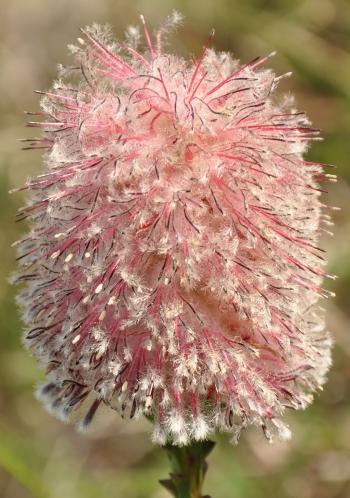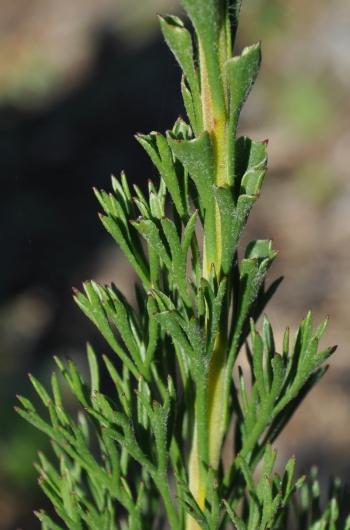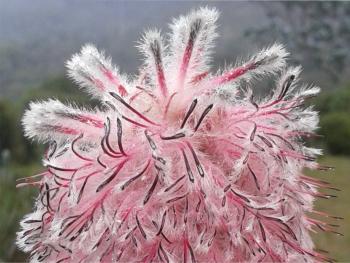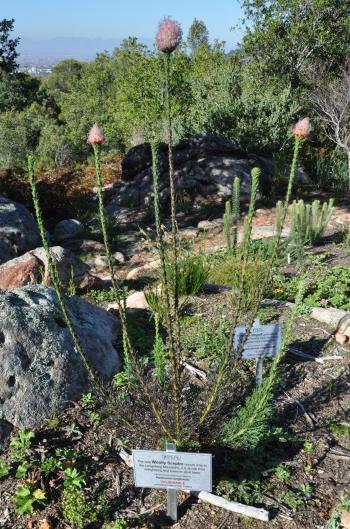Paranomus longicaulis
Paranomus longicaulis Salisb. ex Knight
Family: Proteaceae
Common names: woolly sceptre, exploding baked apple (Eng.); poppiesbos (Afr.)
Introduction
Densely white-woolly, pink and brown flowerheads, forming a short bottlebrush on a long, flowering branch, in spring to summer, with unusual foliage, bearing dissected, entire and spoon-shaped leaves at the same time.

Description
Description
Paranomus longicaulis is an evergreen, sparsely branched shrub, that grows up to 2.5 m high, branching out from a single stem. It has both dissected (divided) and entire leaves of 20–75 mm long, hairless and with rounded tips. The leaves towards the base of the plant are dissected, and the entire leaves are formed above the dissected leaves, and the spatulate (spoon-shaped) leaves are above the entire leaves; they can all be seen on the long stems that branch out from the main stem.

Spatulate leaves subtend the flowerhead, and can be seen at the tip of the flowering stem, surrounding the base of the flowerhead.

The flowerhead is about 30–70 mm long, 30–40 mm in diameter, sometimes forming a bottlebrush-shape. The perianth is 18 mm long, pink at the base and black at the tip, is covered with long, shaggy, silvery white hairs, which give the flowerhead a densely woolly appearance, and there are hardening brown, linear floral bracts at the base. Paranomus longicaulis flowers year round, but most abundantly in spring and early summer (September to December) and drops its smooth, nut seeds a few months after flowering.

Conservation Status
Status
Paranomus longicaulis is Vulnerable (VU) according to the Red List of South African plants, checked in May 2018. It is a rare species, known from a small area, and the wild population is declining due to habitat loss and degradation, caused by invasive aliens, wild harvesting and overgrazing.
Distribution and habitat
Distribution description
Paranomus longicaulis occurs in the Eastern Langeberg from Garcia’s Pass to Attaquaskloof in the Western Cape, on sandstone sands on the lower slopes, at 400–600 m altitude. This plant is only known from 4 populations.

Derivation of name and historical aspects
History
The name Paranomus means ‘illegal’ or ‘beside the custom’ and refers to its out of the ordinary leaves. The species name longicaulis, means ‘long-stemmed’ referring to the flowering branches.
Paranomus is one of 14 genera of the Proteaceae. It comprises of 18 species within the genus. The genus name was given by Richard Salisbury in 1809. He published his work on the Proteaceae soon after the meeting of the Linnaean Society on 7 January 1809, where Robert Brown delivered his pre-publication on Proteaceae. Robert Brown published his work in 1810 and gave this genus the name Nivenia to honour David James Niven (1774–1826), a Scottish plant collector who sent material for description to England. The botanists of the day accused Salisbury of plagiarising Brown’s work and ignored Salisbury’s publication. Thus this genus was known by Brown’s name, Nivenia, until the 1930s, when the rules of botanical nomenclature were enforced and Salisbury’s work was recognized and his genus name restored. Further, the genus Nivenia had also been assigned to a group of irids in 1808, making Brown’s name doubly invalid.
Paranomus longicaulis was first described and named in 1809 by Salisbury from plant material collected by Niven. Brown’s 1810 publication called it Sorocephalus diversifolius, and it was moved into Brown’s genus Nivenia in 1912 by Edwin Phillips and John Hutchinson and thus automatically into Paranomus, when the genus name was restored. Around 1959, Dr Levyns disagreed that Paranomus longicaulis falls under the genus Paranomus and moved it back to Sorocephalus. Ten years later when Dr John Rourke was revising the Sorocephalus, he refuted this, stating that ‘Dr Levyns did not have fresh material and could thus not diagnose the important features of the genus, such as the hardening and woodiness of the floral bracts’. A few years later, Walter Middelmann, the well-known leader of commercial cultivation of Proteaceae, resolved this by bringing a specimen to Dr Rourke to examine at the Compton Herbarium, who determined that it belongs in the genus Paranomus.
Ecology
Ecology
The leaves of Paranomus are sclerophyllous (hard and leathery) as are those of other proteas. Paranomus longicaulis leaves are also dissected (divided) and needle-like and its function is to increase the surface area of the leaf, while saving water by preventing overheating; to increase the surface area of leaf without preventing the sun from reaching the lower leaves; to make if difficult for diseases to spread on the leaves; and to prevent insects and animals from taking large mouthfuls of the leaves.
Paranomus longicaulis is a reseeder, meaning a plant is killed by fire and reproduces by banked seeds in the ground. The smooth, nut seed is covered with an elaiosome, which ants feed on. The ants carry the seeds to their nests underground and eat the elaiosome and leave the seed undamaged in their nest, where it is protected from fire and other animals. These ants do no harm to the seeds. However, rodents, korhaans, pigs and squirrels eat the seeds. Alien invader argentine ants also feed on the elaiosome, but they don’t bury the seed in their nest and the exposed seeds are left to be eaten by rodents and doves, or are burned by fire.
The hard seed coat restricts the penetration of oxygen to the embryo. This delays the germination of the seed. The stored or underground seeds will germinate when senescent plants are removed by fire, and the soil temperature is cool during the night and warm during the day, this is typical of autumn conditions, just prior to the onset of the winter rains. Rodents and insects may eat the seedlings that emerge in a burnt environment free of competition from other plants.
Uses
Use
Paranomus longicaulis is an excellent pot plant. It is a fast-growing species and suitable for fynbos gardens, rock gardens and water-wise gardens. Prune the plant in the pot or in the garden to encourage compact growth and more branches and flowers. Pruning and removal of the old long flowering branches also shapes and produces healthy and vigorous new growth.
Growing Paranomus longicaulis
Grow
Paranomus longicaulis is propagated both by seed and cuttings. Cover the flowerheads with fine netting after all flowers have finished flowering, to prevent the seed eaten by the rodents. Cut the flowerheads off when the seeds start dropping from the flowers, and leave to dry. Then store the seeds in the cold room for 2 weeks prior to sowing. Fruits that are harvested too early will result in immature embryos. The seeds are hard and covered with an elaiosome. Soak the seed in a 1% solution of hydrogen peroxide for 24 hours to soften the seed coat and remove the elaiosome by rubbing on them in the bags between fingers.
Treat the seed with fungicides before planting and once a week after planting, to prevent fungal infections. The sowed seeds should not be allowed to dry out and must be sowed immediately after dusting it with the fungicide. Sow the seed in late summer to autumn (March to May) using a well-aerated growing medium. Treat the seeds with the smoke of burning dry and green fynbos materials by placing the seed trays in a smoking tent, or smoke packets to treat the seed. The seedlings are ready for potting-up after the first pair of true leaves have developed.
Take cuttings of semi-hardwood in autumn and spring and treat with a rooting hormone to stimulate rooting. Stems with dissected leaves root more easily than those with the entire leaves. Dip the cutting in the rooting hormone for at least 5 seconds. Place your cuttings in a well-drained and aerated sowing medium of 70% perlite and 30% fine bark or coarse sand and finely milled pine bark. Insert the cuttings in the multitrays with sufficient space between each cutting to allow air circulation and place them on the heated benches of 25ºC, under intermittent mist. Regularly treat the cuttings with a fungicide to prevent fungal infection. Remove the dead leaves and wilting cuttings until your cuttings are rooted. Move the rooted cuttings to the hardening-off house for about 2 weeks and transplant the cuttings into small nursery plastic bags, using the fynbos soil mixture of well-drained, acidic medium.
Place the seedlings or cuttings under the shade net in the nursery until they are ready to be planted into the garden, after a period of 2 to 3 years. Net shade reduces the direct sun which can dry out the soil in the plastic bags and can also prevent scorching. Plant the seedlings in acidic soil, preferably between 5–7 pH levels.
Keep the soil moist during the hot dry season, by mulching your bed about 5 mm thick. The mulch will keep the roots cool, keep moisture to the soil and reduce the growth of weeds. Chipping mulch is recommended, as they break down very slowly and also releases small amounts of nutrients to the plant. Pruning encourages bushy new growth and removes the long flowering branches and keeps the plants healthy. Paranomus roots are susceptible to Phytophtora root rot, thus keep the plants as undisturbed as possible.
References
- Duncan, G., Brown, N. & Nurrish, L. 2013. Grow proteas. Kirstenbosch Gardening Series. South African National Biodiversity Institute, Cape Town.
- Jackson, W.P.U. 1990. Origins and meanings of names of South African plant genera. University of Cape Town.
- Plants of southern Africa, an online checklist. Accessed 9 May 2018. http://posa.sanbi.org/searchspp.php
- Powrie, F. 1998. Grow South African Plants. A gardener's companion to indigenous plants. National Botanical Institute, Cape Town.
- Protea Atlas Project. Meanings of scientific names. https://www.proteaatlas.org.za/meanings.htm
- Protea Atlas Project. When is a protea by the same name not a protea? The history of the name protea. http://www.proteaatlas.org.za/same.htm
- Rebelo, A.G. et al. 2006. Paranomus longicaulis Salisb. ex Knight. National Assessment: Red list of South African plants version. Accessed on 2018/05/04.
- Rebelo, A.G. 2000. Proteas of the Cape Peninsula. Protea Atlas Project. National Botanical Institute, Cape Town.
- Rebelo, A.G. 2001. Proteas. A field guide to the proteas of southern Africa, edn 2. Fernwood Press, Vlaeberg, Cape Town.
- The International Plant Names Index, I.P.N.I. Accessed 9 May 2018. http://www.ipni.org/ipni/plantnamesearchpage.do
- Vogts, M. 1982. South African's Proteaceae: know them and grow them. Struik, Cape Town.
Credits
Mashudu Nndanduleni
Kirstenbosch National Botanical Garden
May 2018
Plant Attributes:
Plant Type: Shrub
SA Distribution: Western Cape
Soil type: Sandy
Flowering season: Spring, Early Summer
PH: Acid
Flower colour: Brown, White, Pink
Aspect: Full Sun
Gardening skill: Average
Special Features:
Horticultural zones








Rate this article
Article well written and informative
Rate this plant
Is this an interesting plant?
Login to add your Comment
Back to topNot registered yet? Click here to register.